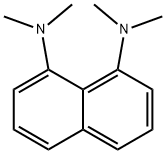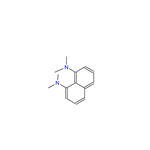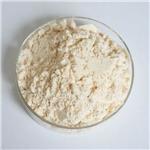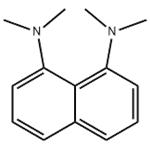Description
Significant attention in organic chemistry has been given to the so-called proton sponges, which are bi-center nitrogen bases that show spectacularly high basicity and very low nucleophilic character. The first member of this class of compounds 1,8-bis(dimethylamino)naphthalene or DMAN dragged attention due to its unexpectedly high basicity (pKa: DMAN 12.1; 1,8-diaminonaphthalene: 4.6) after its discovery in 1941[1]. It is prepared with an 82% yield from 1,8-diaminonaphthalene, dimethyl sulfate, and sodium hydride.
Chemical Properties
1,8-Bis(dimethylamino)naphtalene is pale brownish-pink crystalline powder
Uses
Very strong base in organic synthesis and catalysis.
Uses
1,8-Bis(dimethylamino)naphthalene, also referred to as protone sponge, is a lipophilic proton trapping agent. 1,8-Bis(dimethylamino)naphthalene is used in the matrix for mass spectroscopy analysis of
lipids and fatty acids.
Uses
Very strong base with weak nucleophilic character due to steric effects.
Definition
ChEBI: N1,N1,N8,N8-tetramethylnaphthalene-1,8-diamine is a member of naphthalenes.
General Description
Proton-sponge is also referred as 1,8-dimethylamino naphthalene. It is very strong base with weak nucleophilic character due to steric effects. It also participates in the reactions between arachno-6,9-C
2B
8H
14 and selected acyl chlorides. It has been tested as an effective H
+ scavenger.
Mechanism of action
A possibility of non-conventional two-step protonation of 1,8-bis(dimethylamino)naphthalene (proton sponge) is discussed. Unlike the generally accepted mechanism, involving relatively slow direct penetration of a proton into the cleft between the peri-NMe2 groups, it consists of the rapid addition of a proton to the out-inverted NMe2 group with the subsequent slower rotational transfer of the proton into the inter-nitrogen space to produce a stable chelated cation. The conclusion is that both pathways of proton sponge protonation, traditional and non-conventional, contribute in parallel with a still undefined ratio. The estimated out-basicity of the proton sponge is at least 5.5 orders of magnitude lower than the directly measured in-basicity[2].
Solubility in organics
Soluble in most organic solvents, such as methanol and chloroform.
Purification Methods
It is prepared by methylating 1,8-diaminonaphthalene, and likely impurities are methylated products. The tetramethyl compound is a stronger base than the unmethylated, di and trimethylated derivatives. The pKa values are: 1,8-(NH2)2 = 4.61, 1,8-(NHMe)2 = 5.61, 1-NHMe-8-NHMe2 = 6.43 and 1,8-(NMe2)2 = 12.34. The mixture is then treated with H2O at pH 8 (where all but the required base are protonated) and extracted with Et2O or CHCl3. The dried extract (K2CO3) yields the tetramethyldiamine on evaporation which can be distilled. It is a strong base with weak nucleophilic properties, e.g. it could not be alkylated by refluxing with EtI in MeCN for 4 days; and on treatment with methyl fluorosulfonate only the fluorosulfonate salt of the base is obtained. [NMR: Adler et al. J Chem Soc, Chem Commun 723 1968, Brown & Letang J Am Chem Soc 63 358 1941, Brzezinski et al. J Chem Soc Perkin Trans 2 857 1991.] Alternatively, crystallise proton sponge from EtOH and dry it in a vacuum oven. Store it in the dark in a CO2-free atmosphere. [Benoit et al. Can J Chem 65 996 1987, Beilstein 13 IV 344.]
References
[1] Utsab Bhattacharyya, Ralph Puchta, Renjith Thomas . “The proton sponge 1,8-bis(dimethylamino)naphthalene: The quicker-picker-upper also for s-block metal cations?” Chemical Physics Letters 777 (2021): Article 138735.
[2] Ozeryanskii, Valery A. et al. “Out-Basicity of 1,8-bis(dimethylamino)naphthalene: the experimental and theoretical challenge??.” Organic & Biomolecular Chemistry 15 (2013): 2360–2369.




